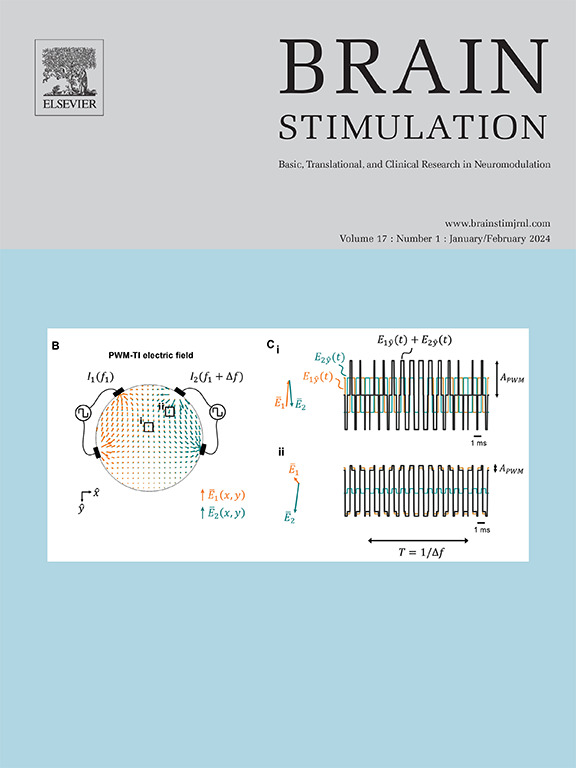Transcranial pulse stimulation modulates neuronal activity and functional network dynamics
IF 8.4
1区 医学
Q1 CLINICAL NEUROLOGY
引用次数: 0
Abstract
Background
Transcranial pulse stimulation (TPS) has recently been proposed as a promising non-invasive technique for treating neurological disorders. While neuropsychological improvements in treated Alzheimer's disease (AD) patients support its safety and preliminary clinical effectiveness, the fundamental mechanisms of TPS action on the brain remain unclear.
Objective
In this study, we explore the effects of TPS on neuronal activity and brain circuitry in healthy and AD mouse models.
Methods
We utilized fluorescence calcium imaging combined with resting-state functional magnetic resonance imaging and c-Fos immunohistochemistry for validation.
We imaged TPS-treated mouse brains expressing genetically encoded calcium indicator and compared the imaging data from AD mouse strains to wild-type controls, followed by immunohistochemical analysis of neuronal activation to support the in vivo imaging findings.
Results
TPS induced robust calcium influxes in GCaMP + mice, increased c-Fos expression in the dentate gyrus, and rapidly but transiently reorganized functional connectivity across brain networks, particularly within the hypothalamus, hippocampus, and other limbic regions. At higher stimulation intensities, TPS is shown to trigger spreading depolarization waves.
Conclusion
These findings support the hypothesis that TPS-induced mechanical effects can effectively modulate brain activity while averting tissue heating and cavitation, thus shedding light on observed beneficial effects in patients and paving the way for further optimization of TPS as a therapeutic strategy for neurodegenerative diseases.
经颅脉冲刺激调节神经元活动和功能网络动力学。
背景:经颅脉冲刺激(TPS)最近被认为是治疗神经系统疾病的一种很有前途的非侵入性技术。虽然经治疗的阿尔茨海默病(AD)患者的神经心理改善支持其安全性和初步临床有效性,但TPS作用于大脑的基本机制尚不清楚。目的:在本研究中,我们探讨TPS对健康和AD小鼠模型神经元活动和脑回路的影响。方法:采用荧光钙成像联合静息状态功能磁共振成像和c-Fos免疫组织化学进行验证。结合静息状态功能磁共振成像,对表达遗传编码钙指示剂的tps处理小鼠大脑进行宽视场荧光钙成像。将AD小鼠菌株的成像数据与野生型对照进行比较,然后对神经元激活进行免疫组织化学分析,以支持体内成像结果。结果:TPS在GCaMP+小鼠中诱导了强劲的钙流入,增加了齿状回中c-Fos的表达,并迅速但短暂地重组了大脑网络中的功能连接,特别是在下丘脑、海马和其他边缘区域。在较高的刺激强度下,TPS可以触发扩张性去极化波。结论:这些发现支持了TPS诱导的机械效应可以有效调节大脑活动,同时避免组织加热和空化的假设,从而揭示了TPS对患者的有益效果,并为进一步优化TPS作为神经退行性疾病的治疗策略铺平了道路。
本文章由计算机程序翻译,如有差异,请以英文原文为准。
求助全文
约1分钟内获得全文
求助全文
来源期刊

Brain Stimulation
医学-临床神经学
CiteScore
13.10
自引率
9.10%
发文量
256
审稿时长
72 days
期刊介绍:
Brain Stimulation publishes on the entire field of brain stimulation, including noninvasive and invasive techniques and technologies that alter brain function through the use of electrical, magnetic, radiowave, or focally targeted pharmacologic stimulation.
Brain Stimulation aims to be the premier journal for publication of original research in the field of neuromodulation. The journal includes: a) Original articles; b) Short Communications; c) Invited and original reviews; d) Technology and methodological perspectives (reviews of new devices, description of new methods, etc.); and e) Letters to the Editor. Special issues of the journal will be considered based on scientific merit.
 求助内容:
求助内容: 应助结果提醒方式:
应助结果提醒方式:


